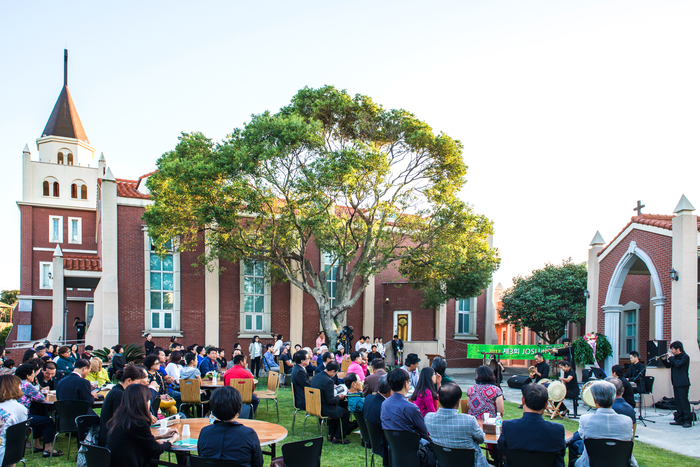|
As a man well past the age of retirement, Pastor Kim Jeong-ki could be forgiven for wanting to take things a little easier.
In 2015, his decade-long project to open a college in the Indian province of Sikkim finally came to fruition as they welcomed 10 students into the freshly built classroom.
These students entering the college meant that his project, the first seeds of which were planted thirty-five years earlier when he made friends with a student from this area in the Himalayas while studying, was finally bearing fruits.
More culture on Jeju
He assures us, however, that he has no plans to take it easy. When we arrive at his church on the western side of Jeju, their summer camp is in full swing with around 50 children doing activities such as art, music, dance, and sports.
Always keen to help out the community, he and his wife have been running art and music classes now for years as a way to bring this kind of cultural activities to both children and adults.
| |
 |
|
| ▲ Josu Biennale Photo courtesy Pastor Kim Jeong-ki |
He got the idea to start helping people further away after meeting a student from Sikkim while studying at ATCS (Asia United Theological University) in Seoul in 1982. However, it wasn’t until a surprise visit from this friend in 2003 that things really took off and the two of them started planning to build the school.
The Sikkim area is one of India’s northernmost states. It borders China, Nepal, Bhutan, and West Bengal and is an area with a similar population to Jeju. It is a rural area and is the largest producer of cardamom in India.
It is no coincidence that both the Pastor’s Jeju church and his college in Sikkim are located in rural locations. He spent years studying for a Ph.D. in the US where he explains that his focus was on how to close the gap between rural and city areas.
By putting on classes on Jeju, or by building a college in a rural area of the Himalayas, he feels he is removing the educational discrepancies between the rural and city areas.
But how did he get to this stage? This story is an eleven-year struggle that is a testament to the power of art and community as a force for good.
| |
 |
|
| ▲ Students at the college in India Photo courtesy Pastor Kim Jeong-ki |
Back in 2007, and knowing that starting a college would require significant funds to set up, Pastor Kim was thinking of ways to raise money.
His first idea was to grow and sell beans. He had been able to come across around 20,000 pyeong (66 thousand square meters) of unused land that was donated to him, and he and his helpers were able to cultivate this and sell the beans.
Following this, he and his wife decided to try to raise money through art. By holding an exhibition, he realized he would both be able to bring art to his rural village in Jeju while raising money for his school in Sikkim.
This was back in 2009. However, once word got out about his plans, and, just as importantly, the good intention behind the plans, help was soon at hand. In fact, soon his friends, people in the local area, and even professional artists were helping him out and donating artwork for him to sell.
This exhibition back in 2009 was to become the first Josu Biennale and with the money received the pastor was able to start building the first floor of the college.
With the success of the first Biennale under his belt, in 2011 Kim Jeong-ki held the second one. Building upon the success of the first the event, the second one featured work from 40 professional artists and they were even able to enlist the help of actress Park Jung-ah who did a monologue.
The third Biennale in 2013 was attended by the then Jeju governor, Woo Keun-min who promised to build a library for the college which was completed in 2014.
The most recent Biennale was the biggest yet and it raised a massive 40 million won which they used to build a female dormitory at the college.
This means that 11 years after Kim Jeong-ki started work on the college, it now has facilities including a dormitory, library, football pitch, and 14 classrooms. The college is now able to take in 50 students, although it is likely to be more when the new semester starts in fall.
When asked about how he feels about the college, Kim Jeong-ki mentioned that he has high hopes for it. He says that he has heard that people in the area think it is a symbol of hope and that his dream is that one day a graduate from the college will become a leader. He described it as a seed that he planted that has grown into what it is today.
|























